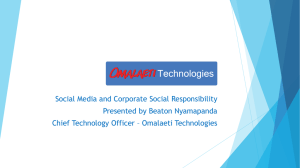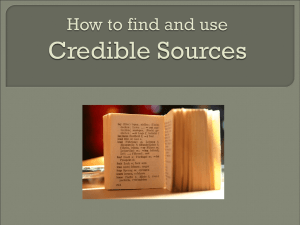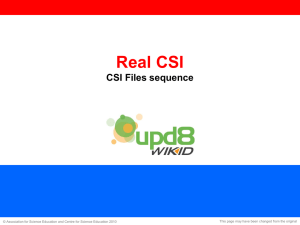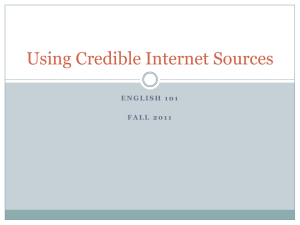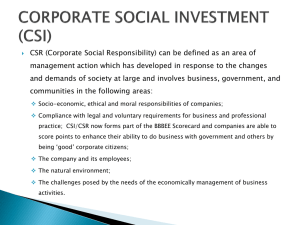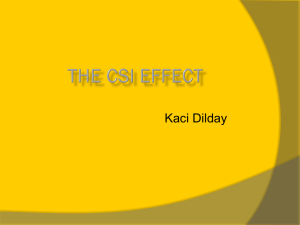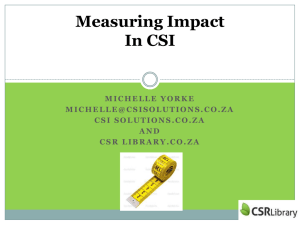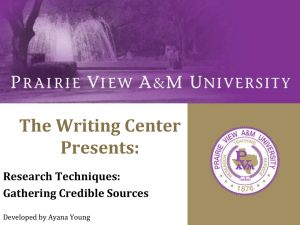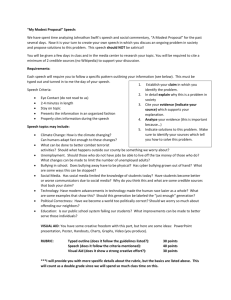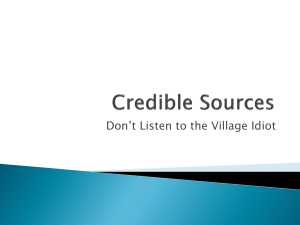Faces and Facets of George Washington
advertisement
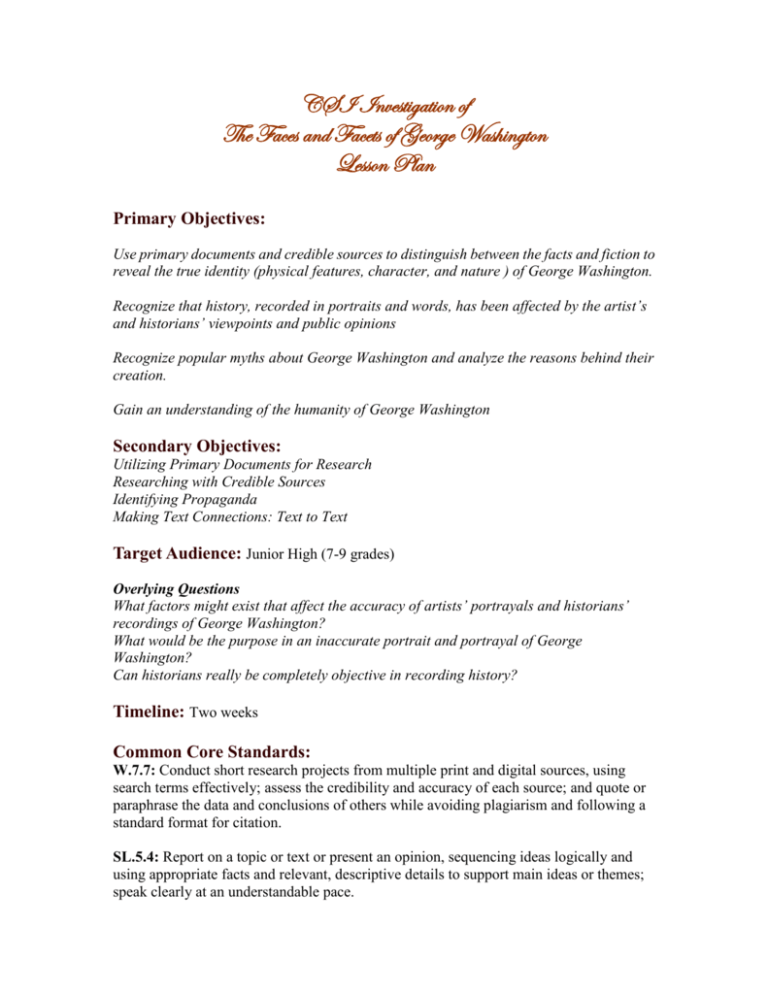
CSI Investigation of The Faces and Facets of George Washington Lesson Plan Primary Objectives: Use primary documents and credible sources to distinguish between the facts and fiction to reveal the true identity (physical features, character, and nature ) of George Washington. Recognize that history, recorded in portraits and words, has been affected by the artist’s and historians’ viewpoints and public opinions Recognize popular myths about George Washington and analyze the reasons behind their creation. Gain an understanding of the humanity of George Washington Secondary Objectives: Utilizing Primary Documents for Research Researching with Credible Sources Identifying Propaganda Making Text Connections: Text to Text Target Audience: Junior High (7-9 grades) Overlying Questions What factors might exist that affect the accuracy of artists’ portrayals and historians’ recordings of George Washington? What would be the purpose in an inaccurate portrait and portrayal of George Washington? Can historians really be completely objective in recording history? Timeline: Two weeks Common Core Standards: W.7.7: Conduct short research projects from multiple print and digital sources, using search terms effectively; assess the credibility and accuracy of each source; and quote or paraphrase the data and conclusions of others while avoiding plagiarism and following a standard format for citation. SL.5.4: Report on a topic or text or present an opinion, sequencing ideas logically and using appropriate facts and relevant, descriptive details to support main ideas or themes; speak clearly at an understandable pace. Comprehension and Collaboration SL.6.2. Interpret information presented in diverse media and formats (e.g., visually, quantitatively, orally) and explain how it contributes to a topic, text, or issue under study. NCSS Standard 2: Time, Continuity, and Change a. Through the study of the past and its legacy, learners examine the institutions, values, and beliefs of people in the past; acquire skills in historical inquiry and interpretation; and gain an understanding of how important historical events and developments have shaped the modern world. Media Curriculum Standards: Strand: Inquiry Standard 1: Identify and Access I.1.8.12 Recognize and access primary and secondary sources Students shall identify, locate, and retrieve appropriate resources for a variety of purposes. I.2.8.1 Use criteria such as validity, currency, accuracy, authority, and scope to determine appropriate resources Background for instructors: On Presidents’ Day profile pictures of George Washington are hung in various rooms of school building across the U.S. Teachers in kindergarten through twelfth grade honor the memory of our Founding Father and First President by sharing short story excerpts, poems, videos or through various forms of presentation. Like the black and white profile cutout that adorns the wall, students are offered an opaque glimpse of the man believed to shaping our nation. In the least, George Washington is worthy of at least a two week classroom study. However, these lessons may be taught out of order and modified to fit the pacing guides of any classroom. Preliminary Planning: Students will need internet access for research in this unit. You may wish to reserve times in your school library lab or computer lab. You might also alternate assignments so one group is completing internet research while others are reading text. Determine one area in your classroom as a “Debriefing Room” and post chart paper, posters of George Washington, and a small book collection for reference in research. A reference booklist is attached to this unit. Pre-order copies or reserve copies from the school library or request an inter-library loan for The Many Faces of George Washington: Remaking a Presidential Icon by Carla Killough McClafferty. Week 1: George Washington, Behind the Mask Day 1: Will the Real George Washington Please Pose for His Portrait? Using a document camera and projector, display an array of photo images of George Washington. (Pages 8-9 of The Many Faces of George Washington: Remaking a Presidential Icon by Carla Killough McClafferty) or National Public Gallery: http://www.npg.si.edu/exh/gw/gwexh.htm Display Author Carla Killough McClafferty’s website http://www.carlamcclafferty.com/ Read about Carla Killough McClafferty and her research on blog: http://cynthialeitichsmith.blogspot.com/2011/06/guest-post-carla-killough-mcclafferty.html Throughout your investigation of George Washington you will be encouraged to utilize many credible book and internet sources. However, the main text for the classroom investigation will be the book, The Many Faces of George Washington: Remaking a Presidential Icon by Carla Killough McClafferty. Author Carla Killough McClafferty has received national attention for her well researched and accurate non-fiction books. (Point out the book titles under Selected Works and awards and recognition) Read chapter one from the book while displaying images to students. Ask students to identify the Real George Washington. Discuss how each portrait is a different interpretation of George Washington. Have students analyze the portraits and the character traits that are exemplified in posture, clothing, and expressions. (example: He appears pompous, regal, elderly, wealthy, stuffy, wise, priestly). Discuss how these artists are those who knew Washington in real life. Guide students through collections of portraits of George Washington: http://www.npg.si.edu/exh/gw/gwexh.htm Compare similarities in the portraits. Discuss age, clothing, and physical features they may have in common. Have students discuss social or physical factors that may have influenced artists to portray George Washington inaccurately in these portraits. Next, display the George Washington of pages 57 and 105 in The Many Faces of George Washington or reference photographs of wax figures at Mount Vernon: http://www.mountvernon.org/visit/plan/index.cfm/sss/95/ Ask students, “Would you recognize this George Washington?” “Do you have an inaccurate picture of George Washington’s appearance and character in your mind?” “In the next two weeks you will become the CSI (Credible Source Investigators) for George Washington. In order to do that you have to have a clear understanding of primary sources of information.” 6. Review the criteria for credible sources of information with whole group. http://owl.english.purdue.edu/owl/resource/588/02/ Discuss credible print sources and how to evaluate them based on the criteria provided in the OWL resource. 7. Divide students into CSI investigating teams. (Small groups of 3 or 4). Assign the following roles: Documents Expert, Recording Agent, Investigative Reporter and (if needed) CSI Editor. 8. Tell students, “You will soon begin investigating cases in your CSI groups, but first you will explore primary and credible sources of information. 9. Send students the assignment via Wiki, Blog or Edmodo or distribute copies of CSI Procedure for Investigating Document (See Attached) 10. Have students work in teams and answer the questions in the on-line web search of credible sources. (15 to 20 minutes). They may post answers on-line and create a file under My Documents on the computer or keep in a file folder. 11. Lead CSI teams in a de-briefing session reviewing the process for researching utilizing credible sources. Have students record answers in their CSI folders. Tell students, “Unfortunately for George Washington, Snopes and Scambusters did not exist and the urban legends about him were not investigated or disproved during his lifetime .” “In the next two weeks you will access credible sources of information in print and on-line that will expose myths and lead you to the facts about George Washington. Your group will keep a folder (online or hardcopy) of your research. You will report at the end of each session, but your evidence must be retained for the final project. Each group will be responsible for a final oral and visual presentation on your findings. The presentation will be evaluated by a rubric. You will receive all of this information this week. “Just remember the keys to locating accurate information:” Author Purpose Objectivity Accuracy Reliability and Credibility Currency Day 2: Sources Revealed Have students gather in de-briefing room. Tell them, “Yesterday you learned about identifying and locating credible sources.” “Today you will access credible sources to learn about our subject of investigation: George Washington. The mission for each CSI team is to utilize credible sources and distinguish the facts from the fiction about George Washington to reveal his true identity.” Distribute Case Study I. “The websites in this case study include interactive portraits of George Washington. George Washington posed for the artist of each portrait. Your CSI investigative team must examine the portraits and record facts about the character, nature, and position of George Washington during the time periods that are revealed in the portrayals. You will also note differences in the portraits and infer ways the artists interpreted his image. You will have 25 minutes on today‘s mission. We will assemble in the debriefing room to discuss your findings.” 1. Distribute GW CSI Case Study I. 2. Supervise students as they research in the lab. 3. Remind students when 15 minutes have passed and ensure they are progressing in the investigation. 4. After 25 minutes, meet with students in the “Debriefing Room” 5. Call on the reporters in each team to provide an overview of their team’s findings. 6. Ask students how the portraits and the objects in the portraits revealed aspects of George Washington. Discuss the web resources and how they met the criteria for credible sources of information. 7. Tell students, “Today you viewed the more familiar portraits of Washington. They provided you a glimpse of George Washington, but tomorrow’s assignment will help you get the form the true picture.” Day 3: George Washington: Identity Revealed 1. Open class session with a display of a Houdon Bust. (Photo, Poster, or bust) http://www.themorgan.org/exhibitions/gwlifemask.asp 2. Use the information from the web page to discuss the process in making the bust and how x-ray revealed the fake aspects to the bust and the laser research uncovered George Washington’s true features. 3. Say to students, “As your first assignment revealed, every known and unknown artist and historian wanted to capture George Washington in portrait or print? So, how can you distinguish fact from fiction or fantasy?” “Crime Scene Investigators consult specialists and rely on technology and artifacts to solve cases. Forensic Anthropologists are often called on to “re-create” the image of a person for identification purposes.” “Today you will investigate the process that Forensic Anthropologist Jeffrey H. Swartz led on an investigative team of specialists under the direction of the leadership of Mount Vernon to find an accurate image of George Washington.” “In your CSI groups, begin investigating by reading chapters 2 and 3 in Carla Killough McClafferty’s book titled “Capturing George Washington” and “Examining George Washington”. “Your roles in the CSI investigation group will remain the same. This time you will be reading to find the answers to specific discussion questions that will be shared with the group.” “Be prepared to report your findings in the debriefing room. Post or distribute copies of the discussion questions. “You will have approximately 20 minutes.” Group Discussion Questions: (post on-line or distribute to students) Who are the Mount Vernon Ladies’ Association? How was technology utilized in re-creating an accurate image of George Washington? Describe the methods and process involved in revealing George Washington. What is the Houdon Bust? How was it created? How are the life mask and the Houdon Bust crucial pieces in revealing the true identity of George Washington? 4. After 20 or 25 minutes, have students meet back in the “Debriefing Room” and review the discussion questions. Tell students that these questions will be answered more thoroughly in tomorrow’s research. Have students save the answers in their CSI group folders. 5. Tell students, “Tomorrow‘s research will be vital in your development of your final project.” Remind students that the key to reliable research is to access and acknowledge credible sources for investigation. Days 4 and 5 : CSI Case Study II 1. Repost the image of the Houdon Bust. Pose questions to the students, “How much have you learned about the man behind the mask?” “What have you learned that was myth and what was factual.” 2. Tell students, “Today and tomorrow you will complete an investigation of George Washington at ages 19, 45, and 57. You will select one of the age periods of George Washington’s life for your final oral and visual presentations.” 3. Post or distribute the CSI Investigation Rubric and Final Project Directions . Display a rubric and discuss the scoring range. 4. Post or distribute CSI Case Study II. Have students work for 20 minutes on the case study. Tell students they will continue the investigation tomorrow. Ensure that students save their work in folders. 5. Meet in the Debriefing Room. Tell students, “Discuss with your CSI team the stages in George Washington’s life that were defined through the life mask and Houdon Bust research (Ages 19, 45, and 57) as displayed at Mount Vernon and detailed in the book by Carla Killough McClafferty. Decide on the age your group will further investigate and direct your research to locating that information.” 6. Distribute the directions and rubric for the final oral and visual assignment. Review the assignment directions with the rubric. Field questions from students and Allow students 20 minutes to brainstorm and plan. Day 5: CSI Case Study II (Continued) 1. Begin the class period with a virtual tour of Mount Vernon: http://www.mountvernon.org/virtual/index.cfm/ss/2/ Guide students through the Education Center highlights: http://www.mountvernon.org/visit/plan/index.cfm/sss/95/ Start with The Mary Morton Parsons Foundation Gallery: Young Virginian and show students how the website will be a great resource for their final projects. 2. Tell students to complete Study Case II and then work on their final project. Remind students they may use book sources and internet sources for their research. Allow students to browse the school OPAC for book sources if needed. 3. Remind students to keep documentation of all sources they access for citations. Week 2 Day 1: The Truth About Teeth, Trees, and George on His Knees 1. Have students complete the Man or Myth Survey of George Washington. (See Attached) 2. Ask students, “Have you read inaccurate stories in the news about public personalities and celebrities? How about the President or Presidential Hopefuls?” 3. Write the word Propaganda on a display. Ask students, “What is Propaganda?” Have a student look the word up in the dictionary and read the definition. 4. “Merriam-Webster defines propaganda as, “ the spreading of ideas, information, or rumor for the purpose of helping or injuring an institution, a cause, or a person” 5. Political opponents and proponents often issue propaganda, sometimes with the belief it will be of benefit. 6. Your next assignments involve two very familiar stories and one celebrated portrait. All three were myths or propaganda created by Mason Locke Weems, a pastor and a bookseller. 7. Post or distribute Case Study III. Tell students to think of these questions. “What statements suggest Weems was not a credible source?” “What would Weems stand to gain by posting inaccurate information?” 8. Allow students 20 minutes at the end of class to work on their final project. Week 2: Day 3: When Words Have Meaning 1. Display a copy of a letter George Washington to Martha Washington, June 1775 http://gwpapers.virginia.edu/documents/revolution/martha.html (Sept 7, 2011). 2. We have learned myths about George Washington, physical features of George Washington, and a few facts about his character. It is time for a deeper investigation of Our Nation’s First President. 3. We can learn the true nature of a person (fictional or factual) through: A. His or her words B. His or her actions C. What other’s (credible sources) say about him or her On the “What Others Say about Them” category you have to use discretion and research to learn who the credible sources are for that person. Here are some questions to consider. What relation did the person have to the character/person? How were the terms of the relationship? Is the person a credible source? Does the person have self-serving motives in giving the testimonial? What does he/she have to gain? Consider those who knew Washington best. What did Martha Washington say about her spouse of years? What did Thomas Jefferson? John Adams? 3. Post or distribute Case Study IV. Tell students, “This case study will provide you with resources and information to assist in your final project. Take advantage of the web recommendation and spend time working on the research. You will search the words and actions of Washington and his closest friends and associates to learn about his character and nature. 4. Utilize the matrix to organize your research. 5. After you complete the matrix, use the websites to gain information for your projects. 6. Note the sources of information and the authority of the sites. Day 6: George Washington and Espionage Have students divide in groups and investigate General George Washington; espionage extraordinaire! 1. Assign roles and have students read the Reader’s Theater, Spies Like Us: The Culper Gang 2. Computer Lab Assignment: Website: http://www.3villagecsd.k12.ny.us/Elementary/minnesauke/3villagehist/SympatheticStain. htm Spy Letters of the American Revolution. Clements Library. The Culper Gang June 27, 1779 -- George Washington to Benjamin Tallmadge http://www2.si.umich.edu/spies/stories-networks-3.html Have students decipher code on website page. Review the document and Have students send a message to each other via Edmodo in secret code Have students design spy message (see directions) Visit the page for Roe Tavern Search documentary: history channel or PBS? http://documentaries.videosift.com/video/The-Truth-Behind-the-Legend-of-George-Wash ington http://www.pbs.org/georgewashington/ http://www.pbs.org/georgewashington/collection/post_presidential1.html http://www.georgewashington.si.edu/life/links.html George Washington: Spy: https://www.cia.gov/library/center-for-the-study-of-intelligence/csi-publications/books-a nd-monographs/the-founding-fathers-of-american-intelligence/art-1.html http://www.tballen.com/george_washington__spymaster_30059.htm Video: http://www.history.com/topics/culper-spy-ring/videos#george-washington To discuss various roles of George Washington http://www.georgewashingtonmythsymbolandreality.org/ Recommended Websites: Now,examine Mount Vernon’s list of Popular Myths about George Washington: http://www.mountvernon.org/visit/plan/index.cfm/pid/808/ George Washington Facts for Dummies http://www.dummies.com/how-to/content/george-washington-an-american-legend.html http://usgovinfo.about.com/od/thepresidentandcabinet/a/gwtheman.htm http://gwtoday.gwu.edu/people/themanthemyththelegend http://usgovinfo.about.com/od/thepresidentandcabinet/a/gwtheman.htm Read the Story of George Washington by Mark Twain: http://etext.lib.virginia.edu/washington/twain/gwbio/index.html Sources George Washington, Spymaster: How Americans Outspied the British and Won the Revolutionary War. By Thomas B. Allen. Illus. by Cheryl Harness. 2004. 190p. National Geographic. Kapoun, Jim. "Teaching undergrads WEB evaluation: A guide for library instruction." C&RL News (July/August 1998): 522-523. (August 25, 2011). McClafferty, Carla K., The Many Faces of George Washington National Portrait Gallery."George and Martha Washington: Portraits from the presidential years" http://www.npg.si.edu/exh/gw/gwexh.htm. (September 5, 2011). NPR. George Washington: Separating Man From Myth, February 21, 2011 http://www.npr.org/2011/02/21/133943644/George-Washington-Separating-Man-FromMyth. (August 27, 2011). University of Virginia Papers of George Washington. “George Washington to Martha Washington 18 & 23 June 177. http://gwpapers.virginia.edu/documents/revolution/martha.html University of Virginia Papers of George Washington. “The Fable of George Washington and the Cherry Tree From The Life of Washington, by Mason Locke Weems, 1809.”http://gwpapers.virginia.edu/articles/weems.html (September 7, 2011). Spirit of Washington. http://georgewashingtoninn.wordpress.com/2009/03/21/the-legend-of-the-cherry-tree/. (August 27, 2011).
